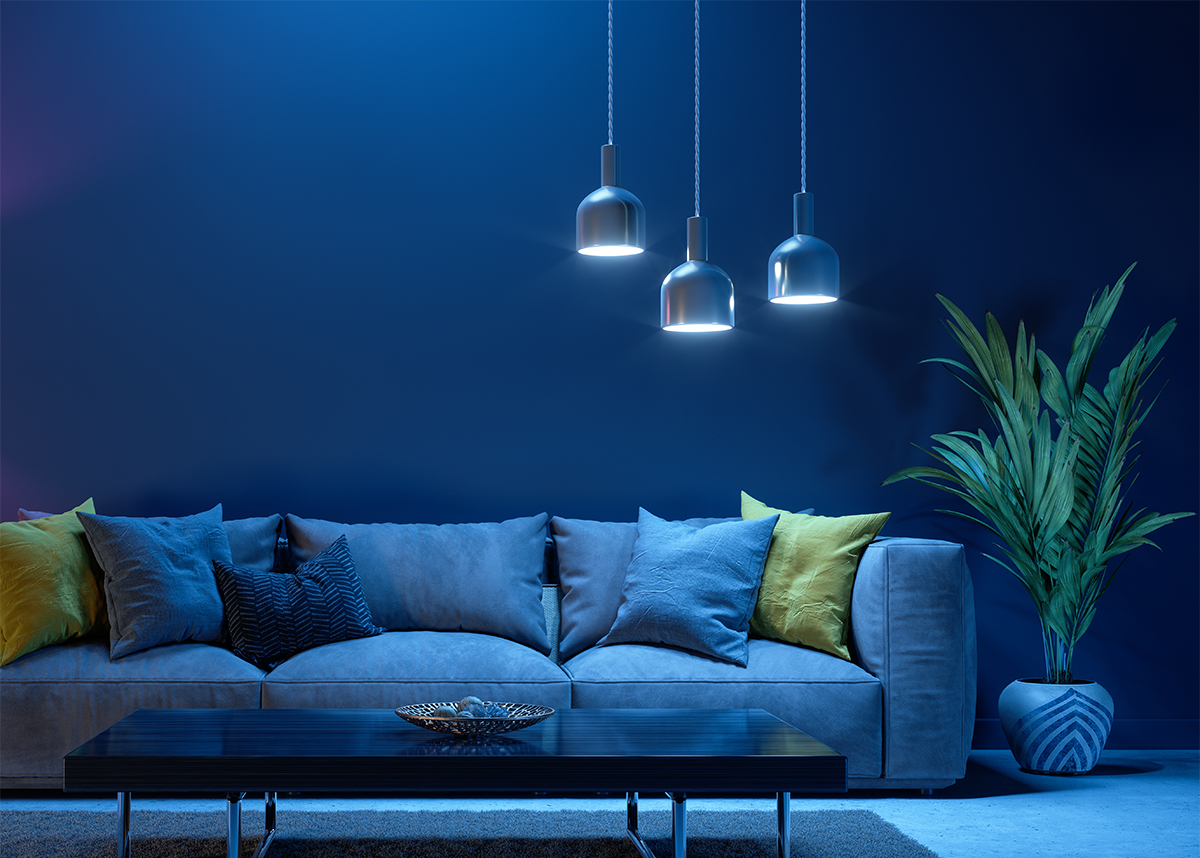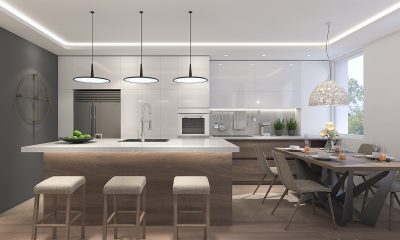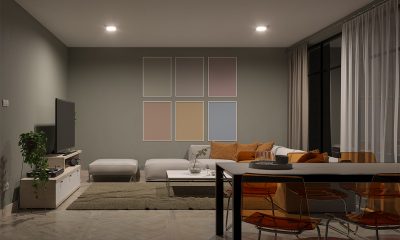What is a smart pendant light
A smart pendant light is an intelligent, networked LED hanging light which can be remotely operated, controlled and automated. The concept of smart lighting for residential and hospitality applications is to provide a convenient, flexible and creative way for people to manage their visual environments.
Pendant lights are amongst the most versatile fixtures. Their footprint can be found in all types of interior spaces such as living rooms, foyers, dining rooms, bedrooms, offices, hotels, restaurants, showrooms and retail stores. They are used to provide the ambient, accent, and task layers of lighting to maximize the use of a space. Hanging gracefully from the ceiling, pendant lighting lends itself to every interior decor. Pendants can stand out as artistic centerpieces to make a grand impression. They can also be designed to subtly blend into the environment they serve and tie the aesthetics of a room together.
Nothing is more satisfying than controlling pendant lights all from the convenience of a smartphone or tablet, making a single environment flexible enough to accommodate visual needs for every occasion and activity, and getting creative with illumination for immersive experiences.
Put the value of lighting in digital context
Smart lighting that resides in pendant lights may be characterized with different features and complexities. In addition to facilitating convenient light management, smart lighting designed for consumer applications is more about good lighting. The intention of maximizing energy savings may be less deliberate. Lighting has a tremendous influence on task visibility, visual performance, mood and atmosphere, visual comfort, aesthetic judgement, social communication, health and well-being. Recognition of these variables leads to an emphasis on the quality of lighting.
Good lighting supplies the appropriate amount of illuminance with an appropriate light spectrum such that it can fulfil the occupant’s visual needs, create a fascinating ambiance and synchronize physiological and psychological rhythms with the natural environment. Aside from the amount and spectrum of light, other variables such as length of exposure and time of day are also qualitative components of lighting design. Smart lighting attempts to address these needs. But with traditional incandescent or fluorescent lighting, this is simply mission impossible.
Explore a new boundary of smart lighting pushed by LED technology
Solid state lighting is at the heart of technological transformation with respect to digital, connected, intelligent, and adaptive lighting. Through recombination of electrons and holes in the active region (quantum well) formed by oppositely doped semiconductor compound layers, LEDs convert electrical energy to photons in the visible wavelength range. LEDs operate efficiently and reliably, which translates to high energy and maintenance savings.
The ability of the semiconductor emitters to provide highly controllable illumination pushed the boundary of smart lighting capabilities. Luminescences arising from electrical influences in direct band gap semiconductors are produced immediately when the p-n junction is biased in the forward direction. LEDs can be switched on and off repeatedly without affecting their service life. This is a huge advantage as compared to fluorescent lamps which have limited switching cycles.
The full range, instantaneous dimmability of LEDs lends them perfectly to digitally controlled applications which necessitate integration of sensors, processors, and network interfaces. The small, dimmable and solid state emitters can be used in different color combinations to create dynamic lighting solutions. Most strikingly, the dynamic feature of tunable white lighting systems allows color temperature to be altered flexibly to suit the varying use of the space. This dimension of controllability is at the core of the latest lighting design innovation.
Creativity abounds with smart pendant lighting
Pendant lighting is a suspended form of lighting that comes in countless designs. From a monopoint configuration created to provide localized lighting for small, cozy spaces to a multipoint configuration that provides scale and coverage for massive great rooms with soaring ceilings, a diverse selection of hanging light fixtures exists to redefine the look and feel of any interior space.
Smart LED pendant lights are crafted using a holistic approach to unite style, function, and sophistication. The LEDs are incorporated into the luminaire through a board module which is an assembly of SMD LEDs populated on a metal-core PCB. The LED module is integrally coupled with a heat sink to ensure that heat generated by the LEDs is adequately transferred to the ambient atmosphere.
In solid white lighting systems, the LEDs are mounted on a printed circuit board (PCB) in a single-circuit configuration. Full-color tuning, tunable white and dim-to-warm systems use a multi-channel design in which LEDs with different colors are mounted on a PCB in mixed combinations. LEDs that emit light in the same color are connected to form a channel that is individually driven and controlled. Controlling the mixing ratio of the component LEDs enables dynamic color generation.
LED driver
In a smart LED pendant light, the LED driver serves a dual role. The foremost responsibility of any LED driver is to provide regulated power for the low voltage, current-driven LEDs. Specifically, the LED driver converts the input of alternating current (AC) of a line voltage into a constant amount of direct current (DC) electrical current under supply voltage or load variations. At the same time, the LED driver executes control input from the light controller, enabling the LEDs to react to the instructions given. From simple brightness adjustment to tunable white lighting that requires independent control of both color temperature and intensity of light, all control strategies designed for dynamic lighting applications count on the driver’s dimming performance.
A constant current LED driver performs dimming control through either pulse-width modulation (PWM) or constant current reduction (CCR). PWM dimming is typically prescribed for color mixing applications where the requirement on color accuracy and stability is tight. With PWM dimming, the duty cycle of a constant current may be adjusted from 0% to 100% to support full-range, digitally controllable dimming while maintaining the color point. CCR or analog dimming is rather simple to implement, but this technology is plagued by a limited dimming range and the color shift problem that occurs at lower drive currents.
Light controller
The control commands that the LED driver executes are originated by the light controller. The controller receives input from connected control devices, cloud servers or sensors. It is a small computer that integrates the microcontroller, computer memory, and input/output (I/O) ports. The microcontroller aggregates data and uses software programs to process data in real-time and make decisions to control the LED driver. LED pendant lights become smart only when they are able to communicate. With wireless network connectivity, not only can a lighting system be controlled remotely via an IP-enabled device, but it can also take advantage of cloud platforms to provide more data processing capabilities and integrate with third party services.
The light controller communicates with control devices and network servers using a transceiver IC. The transceiver IC implements a wireless communication protocols to talk to the network and exchange data over the network. Due to its ubiquity, Wi-Fi is often considered the easiest protocol to work with. Nevertheless, when network scalability and device interoperability are the priorities, ZigBee and Z-Wave become more appealing choices. Bluetooth is another noteworthy protocol. As with Wi-Fi, Bluetooth is directly supported by smartphones and tablets, which eliminates the need for an additional hub or bridge. This protocol, however, is significantly limited in connectivity range and allows for managing only a small group of lights.
App control
The convenience and experience with smart lighting are rooted in the ability to give users the power they need at their fingertips or lips. A very functional and intuitive user interface should be provided by the mobile app that run on an Android or iOS device. The app provides a virtual control panel for users to excise real-time control individual lights or groups of light for on/off switching, dimming and color tuning.
- Program a wide range of routines that automatically come on at set times.
- Play with the color palette and set up scenes to positively influence the mood and atmosphere in a room.
- Sync the dynamically changing light to your favorite music, movies, and games for an extraordinary experience.
- Pair the lights with a smart speaker, such as an Amazon Echo or Google Nest, and use a voice assistant (Amazon Alexa for Amazon Echo, Google Assistant for Google Home) to control your lights.
- Integrate the smart light with cloud-based task automation platforms such as IFTTT to create cool automation recipes.



















Loading...